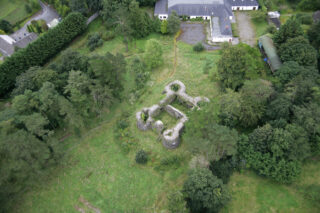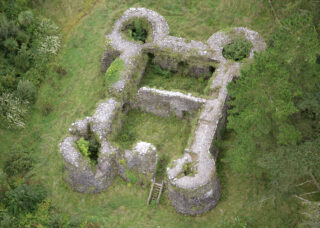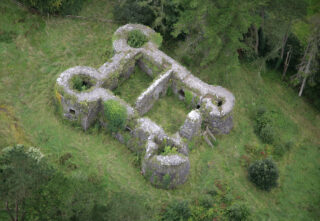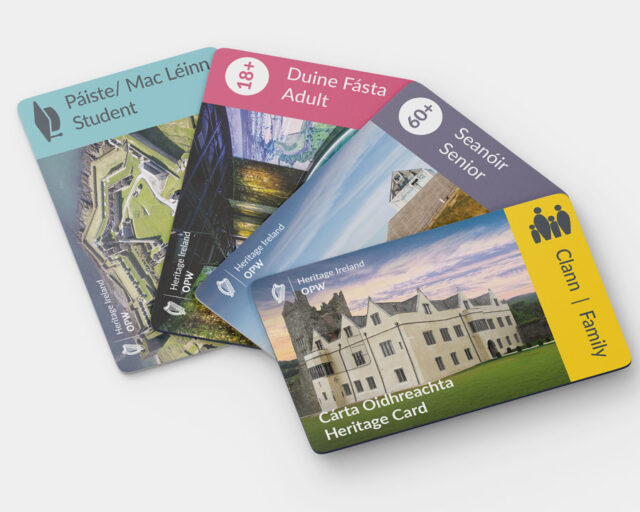Notice
Terryglass Castle is a National Monument in state guardianship
*Not for Public Access*
WARNING: It should be noted that these sites are unguided and a level of care and caution should be maintained during all stages of your visit. The Office Of Public Works (OPW) will not be held responsible for any damages, injuries, or losses that occur
Terryglass Castle
Situated near the north-eastern shores of Lough Derg, the fortified castle at Terryglass (Irish: Tír Dhá Glás, Land of Two Streams)[1] stands today as an impressive ruin. Prior to the construction of the castle, a monastic community existed here established by St. Columba in the 6th This Columba Mac Crimthain of Tír Dhá Glás is not to be confused with the more famous Irish saint known as Columba/Colmcille of Iona, yet both are revered as being among the 12 Apostles of Ireland. Our Columba established the monastery at Terryglass in 548 AD, and a nearby well named for him is said to cure headaches; he died in 552 AD. Terryglass is also associated with St. Patrick himself, who is said to have baptised men of Thomond in the river there, and St. Ruadhán of Lorrha, who has another nearby spring named in his honour.
While an earlier castle complex may have existed here in the 1100s, the four circular towers seen today were built by the Marshalls between 1219 and 1232. Its entrance is to the north, and the bottom of the north-eastern tower may have served as a dungeon, as there is no access to it on the ground; prisoners may have been dropped into it from a higher level. In the north-west tower, a spiral staircase would have allowed archers access to upper levels; arrow loops are to be found all over the castle; there are also gun-loops added on from the early modern period. Today only the first floor of the structure is extant, with the walls forming a rectangular defensive feature between these battery-based towers; the thickness of the walls is unusual given that it predates the use of firearms and cannon:
The walls are of great thickness, when compared to the elevation - they being at least five feet thick, and built with a considerable batter or inclination, for the height of ten or twelve feet from the foundation, which was laid on the naked green sod. It is strange what walls of so great a solidity could have been intended for, as this building must have been erected long prior to the use of gun-powder. Indeed, the very great antiquity of the structure is sufficiently indicated by the fact, that no chimney or fire-place is to be found in any part of it.[2]
John Marshall was indebted to King Henry III of England and this castle was used to secure the surrounding area and procure tax off the local populace. Ownership of Terryglass Castle was transferred to Nicholas Dunheued in the mid-1270s, where the Sherrif Accounts show him in receipt of “£63 11s. for having the guard…of Tyranglas.”[3] Its alternate name of Oldcourt might suggest that it may have functioned as a manor by the time Theobald le Botiller took over possession; surviving documentation from his time shows from 1302 to 1307 Terryglass contributed tax for the Diocese. Richard Óg de Burgh, the Red Earl of Ulster, took possession in 1323, after which it seems to have come under the control of the Butler family. In the Elizabethan period, an English garrison may have been stationed here and, during the reign of King James, Terryglass also provided chancel in 1615 for the Royal Visitation. The Butlers continued to hold the land at Terryglass into the 1640s – at this time the castle may have been partially destroyed due to the occurrence of the Irish Confederate Wars, as were so many other castles in the country at that time.
Visit Historic Environment Viewer for more information on Terryglass Castle
Protect our Past - Click here to read about the importance of protecting our country’s unique heritage sites
This national monument is protected in accordance with the National Monuments Acts 1930 to 2014
[1] Logainm: https://www.logainm.ie/en/46100
[2] B. “Tirdaglas Castle” in The Dublin Penny Journal, Vol. 2, No.75, (Dec. 7, 1833), p. 181, available: https://www.jstor.org/stable/30002977?searchText=terryglass&searchUri=%2Faction%2FdoBasicSearch%3FQuery%3Dterryglass%26so%3Drel&ab_segments=0%2Fbasic_search_gsv2%2Fcontrol&refreqid=fastly-default%3A0dcf6d124ee362eacc5cecf14697bc96&seq=1
[3] Harold G. Leask, Terryglass Castle, Co. Tipperary, available: https://www.jstor.org/stable/25510407?read-now=1&seq=1#page_scan_tab_contents
Gallery
Nearby sites to visit
Portumna Castle and Gardens
Seventeenth-century splendour on the shores of Lough Derg
Approx. 3.7 km from Terryglass Castle
Roscrea Castle, Gardens and Damer House/Black Mills
A place of medieval might and eighteenth-century elegance
Approx. 29.1 km from Terryglass Castle
Clonmacnoise Monastic Site
A spectacular monastery on the banks of the river Shannon
Approx. 33.2 km from Terryglass Castle




